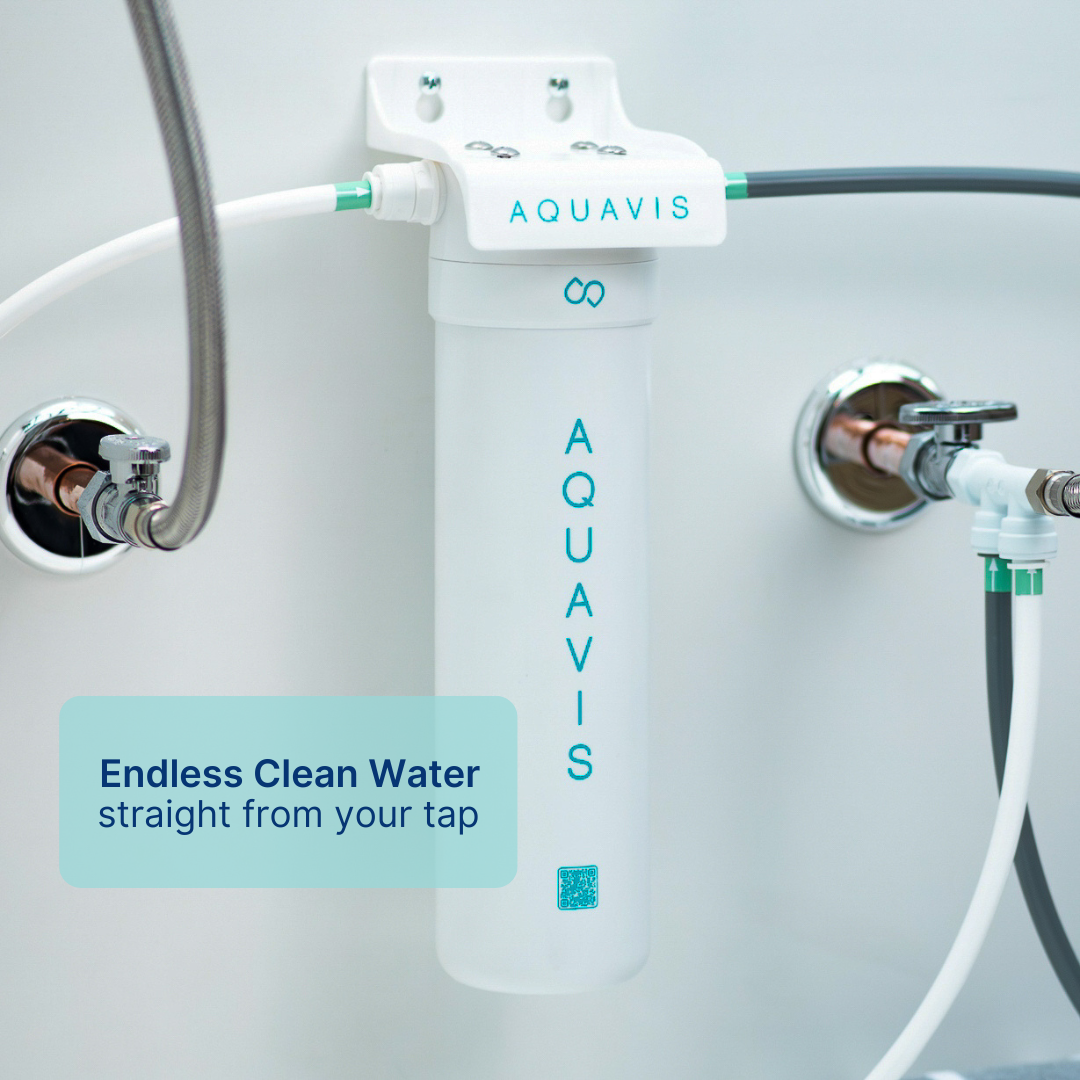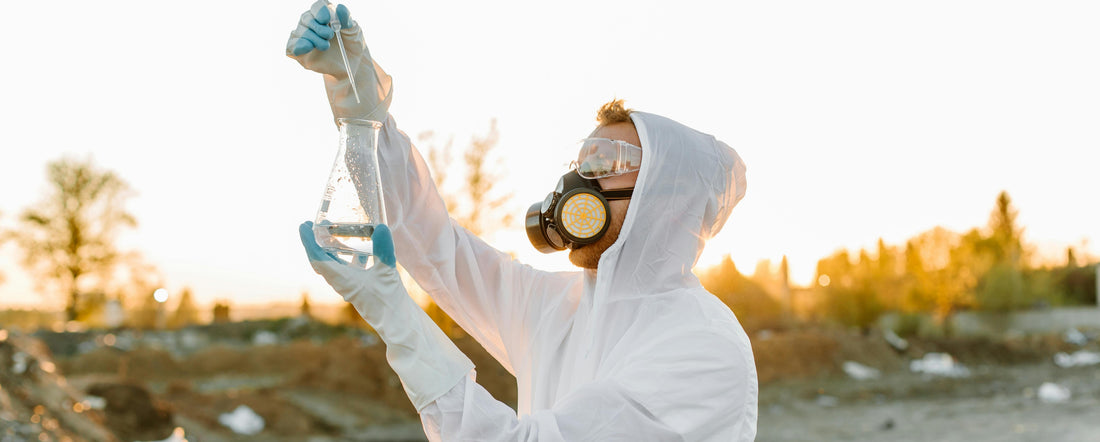It's no secret that untreated water supplies can contain some pretty unsavory natural contaminants. From sediment to bacteria, these unwelcome hitchhikers are not what we're hoping to find in our next glass of water. But did you know that unnatural contaminants like chemicals can also find their way into our public water supplies?
Thankfully, most public water systems remove many natural contaminants before they reach our taps. However, some contaminants—like chemicals—can often slip through the cracks and affect our drinking water quality. In some cases, chemicals are even added into drinking water systems by water treatment plants to disinfect water, effectively removing bacteria, but potentially introducing unsafe levels of chemicals.
So how do these toxic chemicals end up in our water supplies; what are the adverse health effects they cause; and how can we make sure our drinking water stays at a safe exposure level?
We've got the answers! But first, let's take a look at nine common chemicals that might be affecting your tap water.
Nine Common Chemicals in Tap Water
Ever had a sip of tap water that tasted "chemical-y?" Chances are, your senses were spot on. Residual harmful chemicals can often turn up in tap water through various sources, causing potential health effects when consumed over long periods of time.
Here are some of the most common chemicals that you might find in your tap water, how they get there, and what you can do about them in your tap water.
Chlorine
The most recognizable name on our list, chlorine is a common contaminant chemical frequently found in tap water. Chlorination is an effective drinking water disinfection method utilized by many municipal water treatment plants to provide cleaner drinking water. Unfortunately, it can be difficult to remove chemical disinfectants from water. As a result, chlorinated water often makes it into our homes and faucets.
How it gets into water: While chlorine may find its way into water as an unintentional pollutant like other synthetic chemicals, this chemical is most commonly added into community water systems by water treatment officials to reduce the health risks caused by bacteria. Disinfection of public supplies is crucial to supplying communities with safe drinking water, but the chemicals used to disinfect water may not be fit for physical consumption.
How it affects health: Public water chlorination can help protect communities against waterborne disease outbreaks, but like the old adage says, you can have too much of a good thing. As might be expected, high levels of exposure to chlorinated drinking water can have adverse long-term health effects such as gastrointestinal issues.
How it can be removed: Because water chlorination can be helpful for disinfecting large amounts of water, removing it at a municipal level may not be the answer. However, to avoid the potential health harms caused by over-consumption, consider filtering the water in your own home.
Under-sink filters like those from Aquavis can help remove excess levels of chlorine leaving your family with healthier, tastier tap water.
Volatile Organic Compounds
Volatile organic compounds (VOCs) are a diverse group of compounds that can evaporate into the air and dissolve in water. Common VOCs found in water include benzene, chloroform, and trichloroethylene. Monitoring and controlling VOC levels in water are essential for ensuring safe drinking water and protecting aquatic life.
How they get into water: VOCs can originate from various sources such as industrial discharges, agricultural runoff, and improper disposal of chemicals. Typically, these harmful chemicals seep into the ground and pollute our groundwater supplies.
How they affect health: VOCs can pose significant risks to both human health and the environment if they contaminate drinking water supplies and aquatic ecosystems. Exposure to these chemicals may cause headaches, nausea, and damage to the liver, kidneys, and nervous system.
How they can be removed: Water treatment processes such as activated carbon filtration (utilized by the Aquavis Pulse) can help remove VOCs from water supplies, reducing their potential impact on public health and the environment.
Herbicides
Similar to pesticides, herbicides are chemicals specifically designed to control or kill unwanted plants—most commonly, weeds. Once in water, herbicides can pose risks to human health through direct exposure during recreational activities like swimming or through the consumption of contaminated drinking water.
How they get into water: These chemicals can enter water sources through various pathways such as agricultural runoff, improper disposal, and surface runoff from treated areas like lawns and gardens.
How they affect health: Made to kill plants, herbicides are known to contain some pretty toxic ingredients. Some of these ingredients can act as hormone disruptors while others can cause adverse effects on the nervous system and reproductive health.
How they can be removed: Removing herbicides from water can be challenging but achievable through water treatment methods such as activated carbon filtration or reverse osmosis processes.
Pharmaceuticals
Pharmaceuticals are substances designed and utilized for medicinal purposes such as prescription drugs, over-the-counter medications, and veterinary drugs. Once in water, pharmaceuticals can have diverse impacts on human health, wildlife, and aquatic ecosystems.
How they get into water: These compounds can enter water sources through various routes such as excretion from humans and animals, improper disposal of unused medications, and wastewater from pharmaceutical manufacturing plants.
How they affect health: Prolonged exposure to low levels of pharmaceuticals in drinking water may raise concerns about potential health effects, including the creation of antibiotic resistant bacteria.
How they can be removed: Removing pharmaceuticals from water requires advanced treatment technologies such as ozone oxidation and powdered activated carbon treatment. Proper medication disposal practices and effective wastewater treatment processes are also essential steps in lessening pharmaceutical contamination.
Cysts
Cysts are microorganisms that can cause waterborne diseases like Giardia and Cryptosporidium when ingested. Regular monitoring and maintenance of water treatment systems are crucial to ensuring the removal of cysts and maintaining safe drinking water standards for communities.
How they get into water: Water sources can become polluted by cysts through contamination from human or animal waste, especially in areas that lack sanitation or produce large amounts of agricultural runoff.
How they affect health: Drinking water contaminated with cysts can cause gastrointestinal illnesses like Giardia, which can elicit symptoms such as diarrhea, nausea, and abdominal cramps. These contaminants pose a significant health risk to children and immunocompromised individuals.
How they can be removed: Cysts can be removed from water using specialized treatment processes such as activated carbon filtration (as used in the Aquavis Pulse), reverse osmosis, and water purification methods.
Disinfection Byproducts
Disinfection byproducts (DBPs) are formed when disinfectants such as chlorine react with organic and inorganic particles in water during the water treatment process. These disinfectants are essential for killing harmful pathogens and ensuring water safety, but their reaction with organic compounds can lead to the formation of DBPs.
How they get into water: DBPs can enter water distribution systems that supply tap water through the disinfection process itself or from reactions with organic matter in raw water sources like rivers and lakes.
How they affect health: Prolonged exposure to certain DBPs, such as has been linked to potential health risks, including increased cancer risk and damage to the liver and nervous system.
How they can be removed: Removing DPBs requires using alternative disinfection methods like chloramine or ozone, reducing organic material in untreated water, and using advanced treatments like activated carbon filtration.
Nitrate
Nitrate is a chemical compound composed of nitrogen and oxygen that naturally occurs in soil, water, and air. However, humans are often the culprits behind elevated levels of nitrate in water sources.
How it gets into water: Nitrate can pollute water through means such as agricultural runoff, sewage discharges, and industrial activities. Excessive nitrate levels in water can also stem from the leaching of nitrogen-based fertilizers into groundwater.
How it affects health: When consumed in high concentrations, nitrate can interfere with oxygen transport in the blood, posing health risks to infants and pregnant women.
How it can be removed: Removing nitrates from water typically involves treatment processes like ion exchange or reverse osmosis which can effectively reduce nitrate concentrations to safe levels.
Coliform
Coliform bacteria are a group of microorganisms found in soil, vegetation, and animal feces. While most coliform bacteria are harmless, their presence in water can indicate potential fecal contamination and the possible presence of harmful pathogens such as E. coli.
How it gets into water: Coliform bacteria can enter water sources through sewage overflows, agricultural runoff, and faulty septic systems.
How it affects health: High levels of coliform bacteria in drinking water can pose a risk of waterborne diseases, causing symptoms such as diarrhea, vomiting, and abdominal cramps.
How it can be removed: Treatment methods such as chlorination, ultraviolet (UV) filtration, and other purification processes can effectively remove coliform bacteria and other pathogens, reducing the risk of waterborne illnesses.
PFAS
Perfluoroalkyl and polyfluoroalkyl substances (PFAS) are a group of human-made chemicals that have been widely used in various products for their water and stain-resistant properties. Also known as "forever chemicals," PFAS are extremely persistent and don't easily break down. Efforts to regulate and monitor PFAS levels in water sources are crucial for protecting public health and minimizing environmental contamination from these persistent chemicals.
How they get into water: PFAS can enter water sources through industrial discharges, firefighting foams, and landfills.
How they affect health: Exposure to PFAS has been linked to adverse health effects such as heightened cholesterol, hormone disruption, thyroid disease, and certain types of cancer.
How they can be removed: Removing PFAS from water is challenging due to their pervasive and durable nature. Fortunately, advanced treatment technologies such as activated carbon filtration (used by the Aquavis Pulse) and reverse osmosis can help reduce PFAS levels in drinking water.
Why Do These Chemicals End Up in Our Water?
Unfortunately, our world is full of chemicals. And chemicals found in tap water can originate from various sources throughout the water treatment and distribution process. This reality makes it extremely difficult to eliminate chemicals from our municipal water at the source, which means we must address these dangerous contaminants within our own homes. That's where in-home water filtration comes in.
Filtered Tap Water: Clean Water
Water filters such as activated carbon filters are highly effective at removing a wide range of chemicals from tap water. Activated carbon is a porous material with a large surface area that can adsorb (attract and hold onto) contaminants effectively.
When water passes through an activated carbon filter, organic compounds such as chlorine, volatile organic compounds (VOCs), pesticides, and some heavy metals are trapped within the carbon pores through adsorption. Additionally, activated carbon can also adsorb unpleasant tastes and odors from water, improving its overall quality and taste.
Try Aquavis Today!
At Aquavis, we value health, safety, and convenience. That's why we created the Aquavis Pulse: an activated carbon filter that can be easily installed under your sink in minutes.
Try Aquavis today and help keep your family's water supply healthy and safe!


